Investigation of the Effects of Different Working Fluids on Compressor Cascade Performance
Abstract
:1. Introduction
2. Theoretical Analysis
3. Computational Techniques
3.1. Computational Model
3.2. Mesh Sensitivity Study
3.3. Computational Method Authentication
4. Performance Analysis
4.1. Effect of Physical Properties on Coefficient of Total Pressure Loss
4.2. Effect of Physical Properties on Static Pressure Ratio
5. Conclusions
- (1)
- Coefficient of total pressure loss is only linked to the specific heat ratio and Mach number of the working fluid at a matching Reynolds number. The greater specific heat ratio working fluid has a greater coefficient of total pressure loss.
- (2)
- Coefficient of total pressure loss increases by the increase of Mach number. Coefficient of total pressure loss of helium and carbon dioxide is calculated using Equation (13) and validated. The relative prediction error is less than 5%, which is enough to meet the engineering demand.
- (3)
- The relationship of compressor cascade static pressure ratio using dissimilar working fluid is governed by specific heat ratio and inlet relative Mach number. Higher specific heat ratio fluid has higher static pressure and variance rises with rise in Mach number.
- (4)
- Equation (15) accurately predicts the cascade static pressure ratio using other fluids. Predictive relative error is less than 8%, which is enough to meet the engineering demand.
- (5)
- When attack angle is fixed, flow separation in compressor cascade depends on adverse pressure gradient. Specific heat ratio and Mach number of working fluid affect flow separation in compressor cascade by influencing static pressure ratio in cascade.
Author Contributions
Funding
Institutional Review Board Statement
Informed Consent Statement
Data Availability Statement
Conflicts of Interest
Nomenclature
| D | Length, m |
| p | Pressure, Pa |
| γ | Specific heat ratio |
| Pr | Prandtl number |
| Br | Brinkman number |
| Pe | Peclet number |
| A | Area, m2 |
| Re | Reynolds number |
| f | Friction factor |
| ω | Total pressure loss coefficient |
| T | Temperature, k |
| π | Pressure ratio |
| ρ | Density, kg/m3 |
| Rg | gas constant, J/(kg*k) |
| V | Velocity, m/s |
| Ma | Mach number |
| Sr | Strouhal number |
| Eu | Euler number |
| Cp | Static pressure coefficient |
| Subscripts | |
| * | Stagnation |
| 1 | Inlet |
| 2 | Outlet |
| A | Working fluid |
| B | Working fluid |
References
- Energy Information Administration. International Energy Outlook 2017; Energy Information Administration: Washington, DC, USA, 2017; pp. 3–143. Available online: https://www.eia.gov/outlooks/ieo/pdf/0484(2017).pdf (accessed on 14 September 2017).
- Behar, O.; Khellaf, A.; Mohammedi, K. A review of studies on central receiver solar thermal power plants. Renew. Sustain. Energy Rev. 2013, 23, 12–39. [Google Scholar] [CrossRef]
- Lee, J.J.; Kang, D.W.; Kim, T.S. Development of a gas turbine performance analysis program and its application. Energy 2011, 36, 5274–5285. [Google Scholar] [CrossRef]
- Anheden, M. Analysis of Gas Turbine Systems for Sustainable Energy Conversion. Ph.D. Thesis, Royal Institute of Technology, Stockholm, Sweden, 2000. [Google Scholar]
- Al-Attab, K.A.; Zainal, Z.A. Externally fired gas turbine technology: A review. Appl. Energy 2015, 138, 474–487. [Google Scholar] [CrossRef]
- Kim, Y.M.; Kim, C.G.; Favrat, D. Transcritical or supercritical CO2 cycles using both low- and high-temperature heat sources. Energy 2012, 43, 402–415. [Google Scholar] [CrossRef]
- Mcdonald, C.F. Helium turbomachinery operating experience from gas turbine power plants and test facilities. Appl. Therm. Eng. 2012, 44, 108–142. [Google Scholar] [CrossRef]
- Wang, Z.G.; Wang, Y.; Zhang, J.Q.; Zhang, B.C. Overview of the key technologies of combined cycle engine precooling systems and the advanced applications of micro-channel heat transfer. Aerosp. Sci. Technol. 2014, 39, 31–39. [Google Scholar] [CrossRef]
- Ahn, Y.; Bae, S.J.; Kim, M.; Cho, S.K.; Baik, S.; Lee, J.I.; Cha, J.E. Review of supercritical CO2 power cycle technology and current status of research and development. Nucl. Eng. Technol. 2015, 47, 647–661. [Google Scholar] [CrossRef] [Green Version]
- Tian, Z.; Zheng, Q.; Malik, A.; Jia, X.; Jiang, B. Effect of the specific heat ratio on transonic axial compressor rotor performances. Appl. Therm. Eng. 2019, 148, 307–315. [Google Scholar] [CrossRef]
- Weisbrodt, I.A. Summary Report on Technical Experiences from High Temperature Helium Turbine Testing in Germany; IAEA-TECDOC-899; International Atomic Energy Agency (IAEA): Vienna, Austria, 1994. [Google Scholar]
- Iverson, B.D.; Conboy, T.M.; Pasch, J.J.; Kruizenga, A.M. Supercritical CO2, Brayton cycles for solar-thermal energy. Appl. Energy 2013, 111, 957–970. [Google Scholar] [CrossRef] [Green Version]
- Kato, Y.; Niktawaki, T.; Yoshizawa, Y. A carbon dioxide partial condensation direct cycle for advanced gas cooled fast and thermal reactors. In Proceedings of the Global 2001, Paris, France, 9–13 September 2001; pp. 1–8. [Google Scholar]
- Utamura, M.; Tamaura, Y. A Solar Gas Turbine Cycle with Super-Critical Carbon Dioxide as a Working Fluid. In ASME Turbo Expo 2006: Power for Land, Sea, and Air; ASME: New York, NY, USA, 2006; pp. 329–335. [Google Scholar]
- Stephen, K.R.; Steen, A.S. Effect of the specific heat ratio on the aerodynamic performance of turbomachinery. J. Eng. Gas Turbbines Power 2005, 127, 773–780. [Google Scholar]
- Stephen, K.R.; Steen, A.S. Semi-closed cycle O2/CO2 combustion gas turbines: Influence of fluid properties on the aerodynamic performance of the turbomachinery. In ASME Turbo Expo 2002: Power for Land, Sea, and Air; ASME: New York, NY, USA, 2002; pp. 663–673. [Google Scholar]
- Zhu, R.K.; Zhang, J.; Zheng, Q.; ZOU, J.G. A study of similarity problems concerning the working media helium and air in an axial-flow compressor. J. Eng. Therm. Energy Power 2008, 23, 595–600. [Google Scholar]
- Zhu, R.; Zheng, Q.; Yue, G.; Zou, J. Researches of similitude theory for axial flow helium compressor. In ASME Turbo Expo 2008: Power for Land, Sea, and Air; ASME: New York, NY, USA, 2008; pp. 247–254. [Google Scholar]
- Jiang, B.; Chen, Z.; Chen, H.; Zhang, H.; Zheng, Q. Similarity and cascade flow characteristics of a highly loaded helium compressor. Nucl. Eng. Des. 2015, 286, 286–296. [Google Scholar] [CrossRef]
- Lu, H.; Yang, Y.; Guo, S.; Pang, W.; Yang, F.; Zhong, J. Control of corner separation via dimpled surface for a highly loaded compressor cascade under different inlet Mach number. Aerosp. Sci. Technol. 2019, 85, 48–60. [Google Scholar] [CrossRef]
- Zhitao, T. Research on the Performance and Design Method of Helium Compressor. Ph.D. Thesis, Harbin Engineering University, Harbin, China, 2019. [Google Scholar]
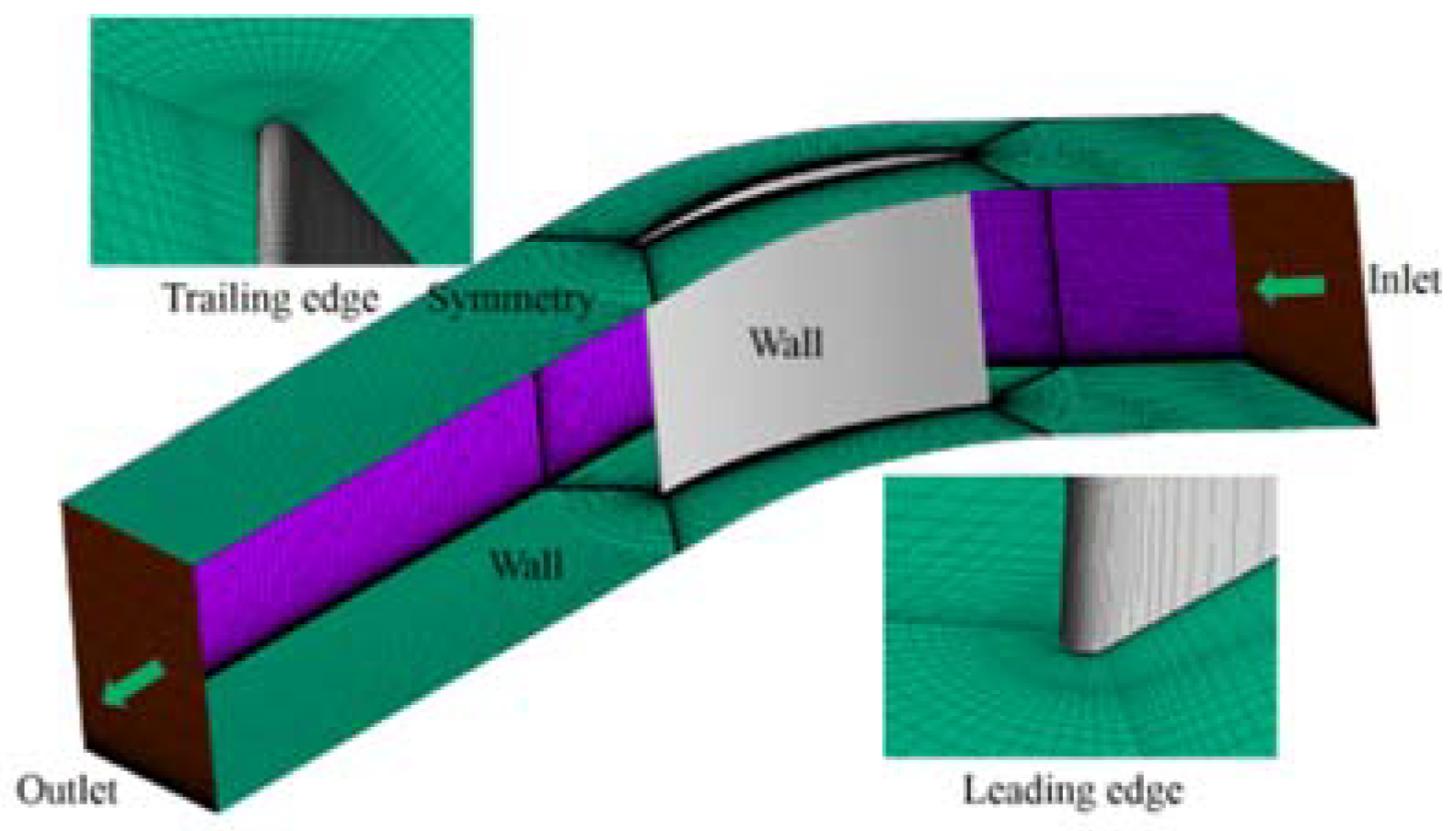


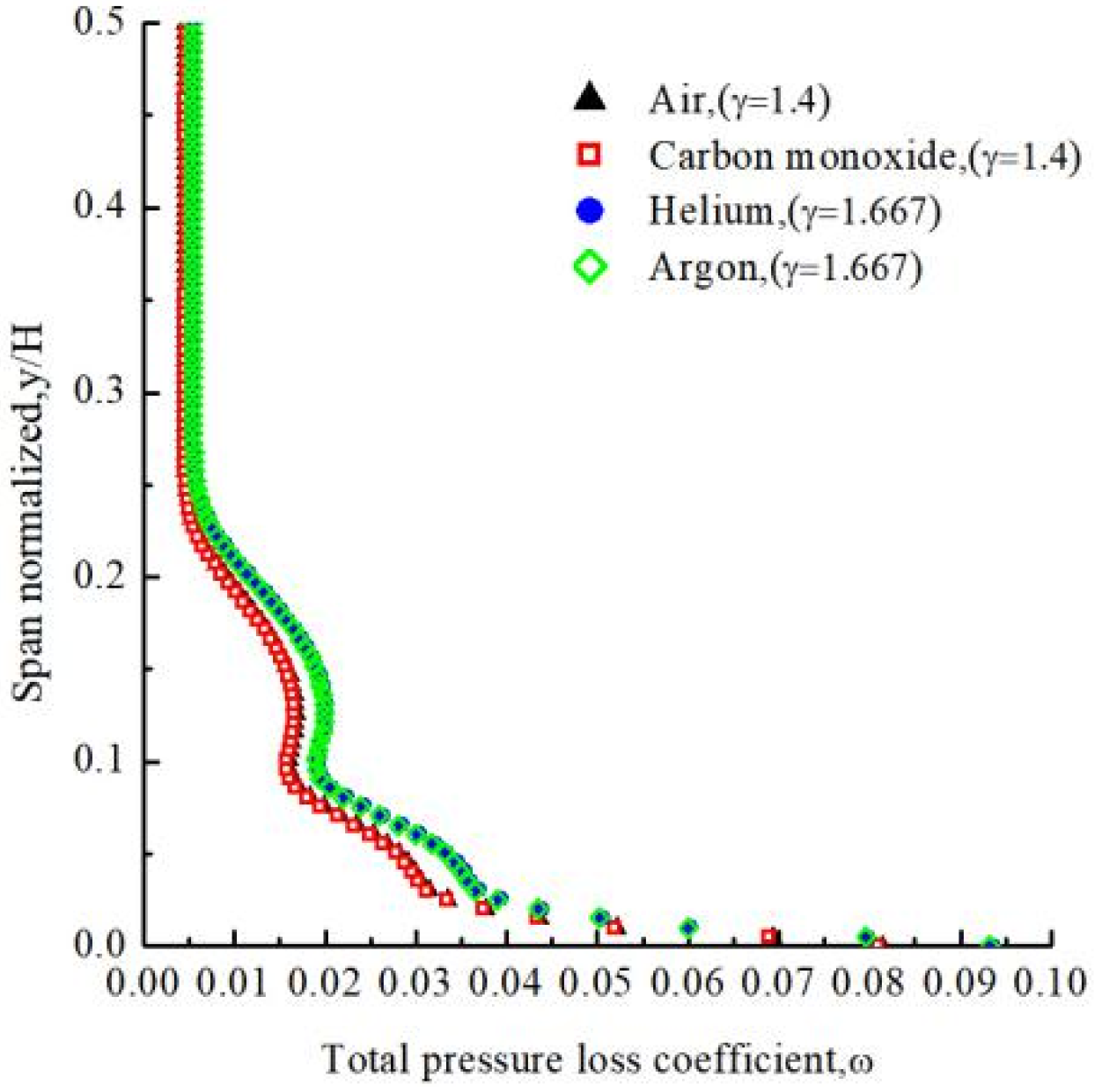
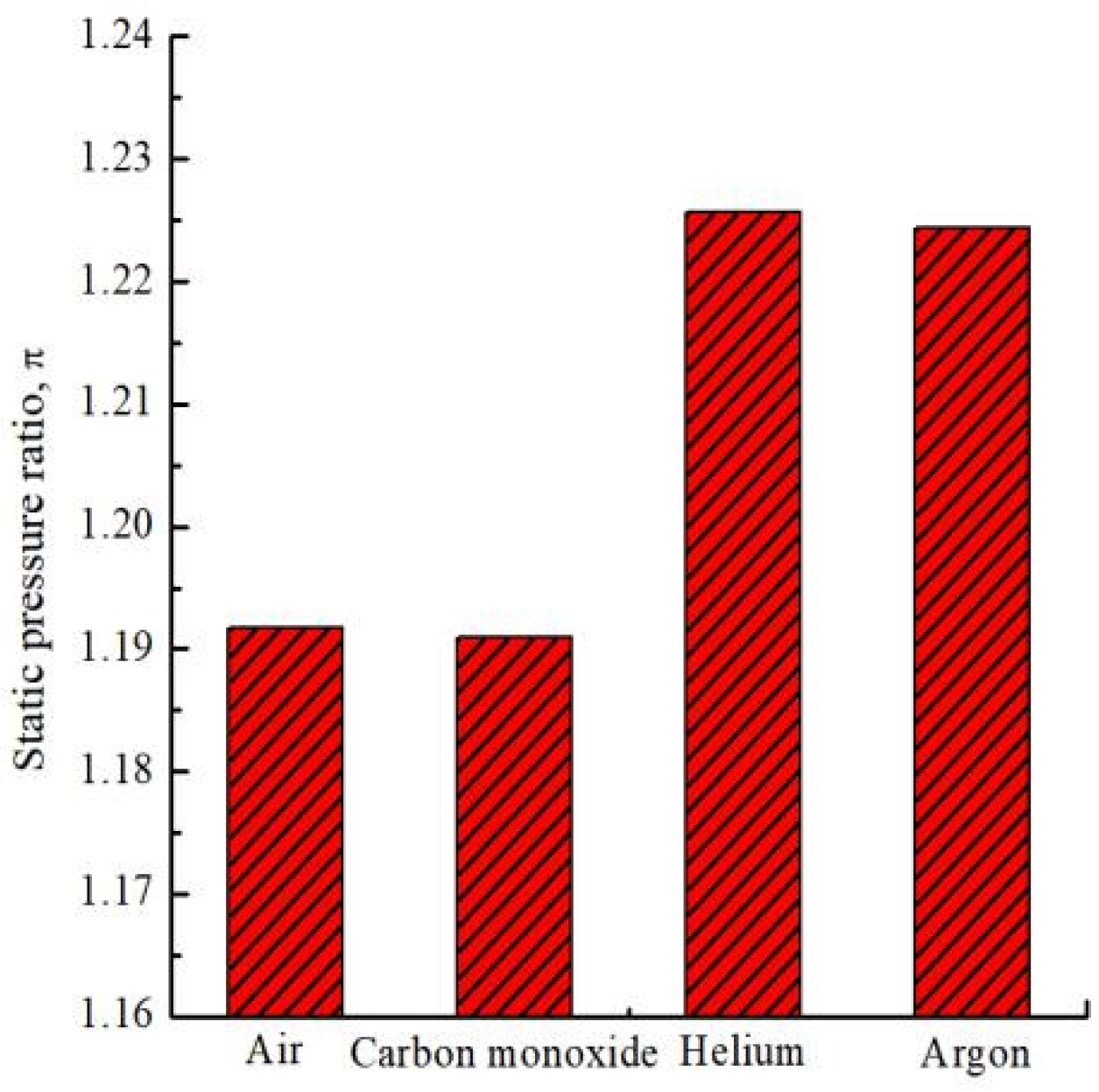
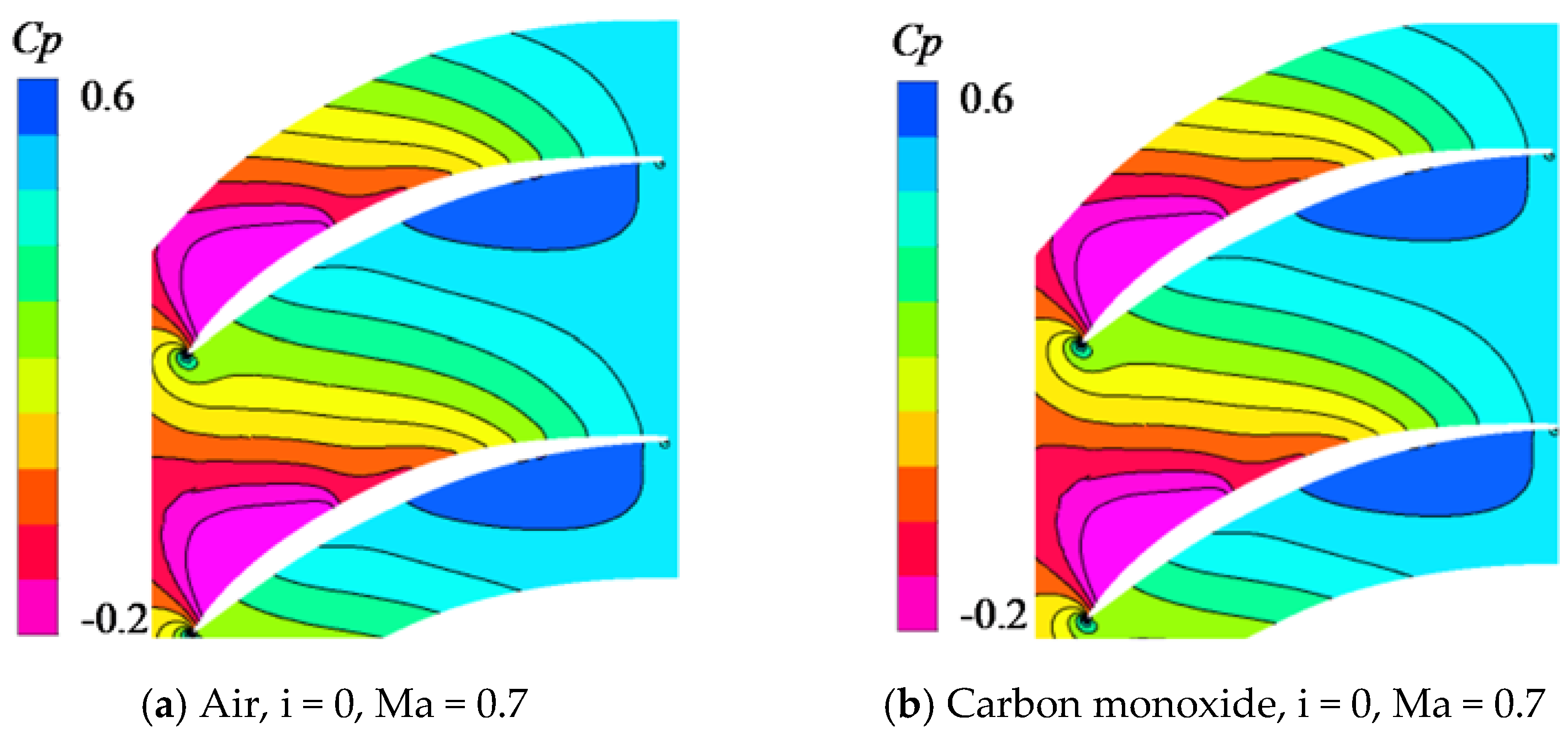


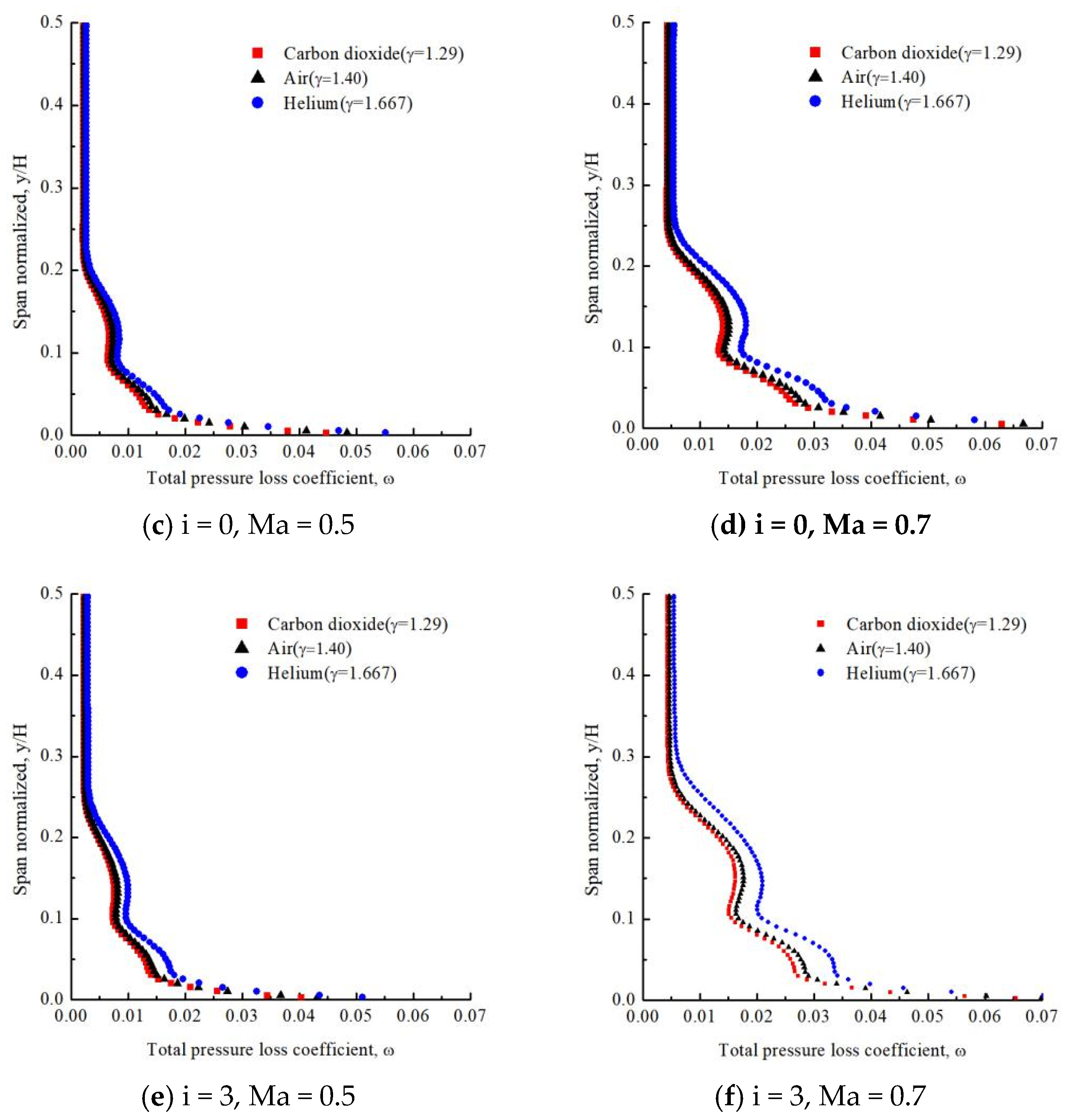

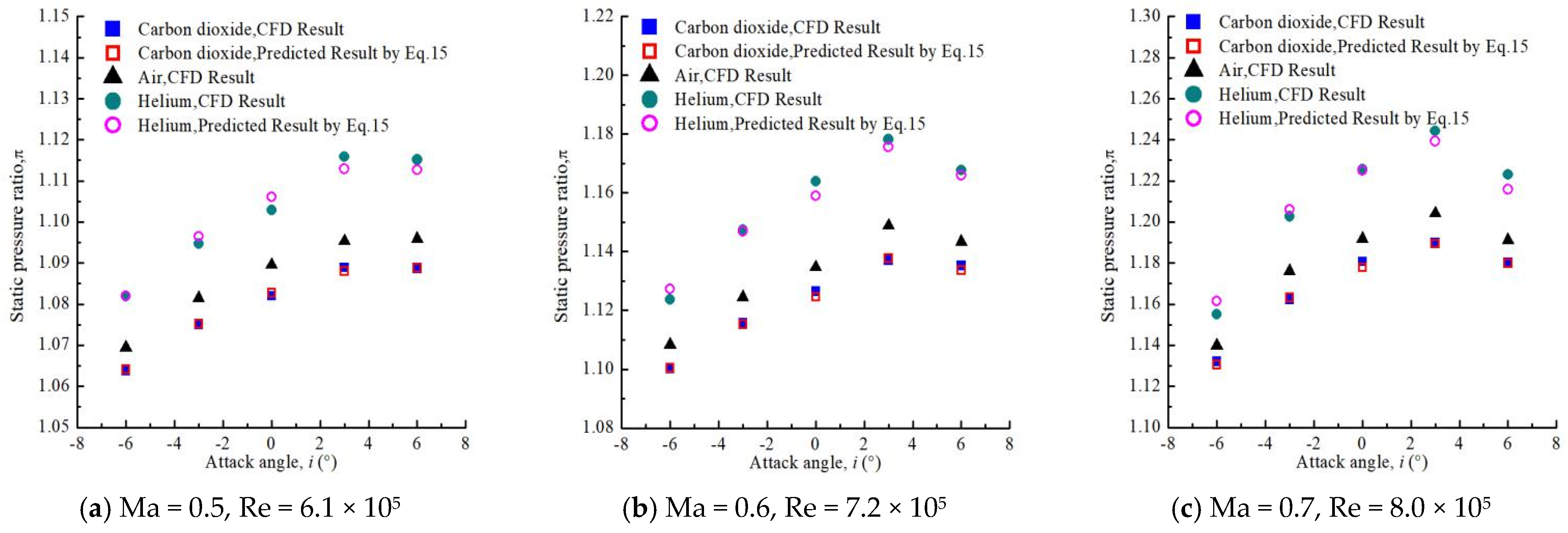


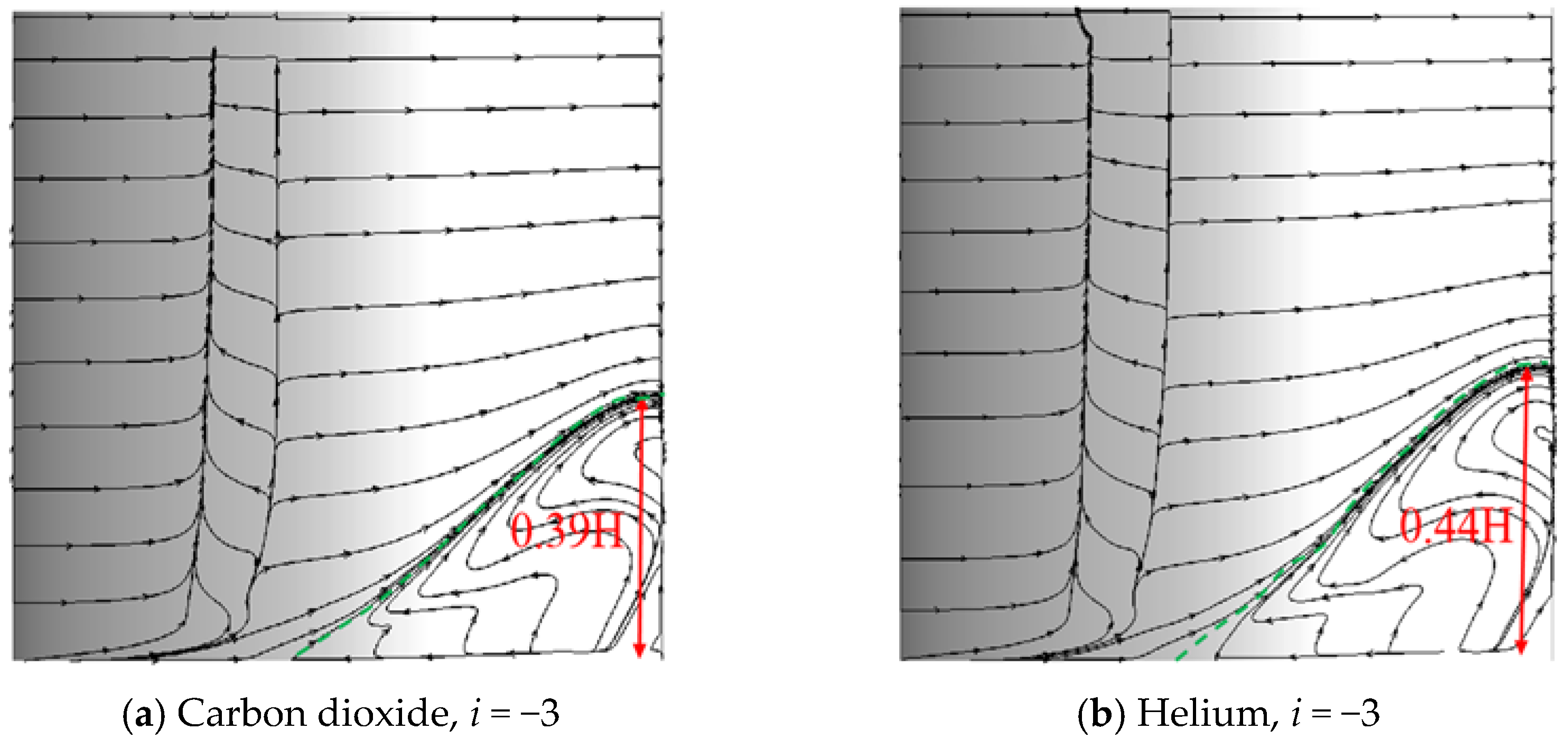
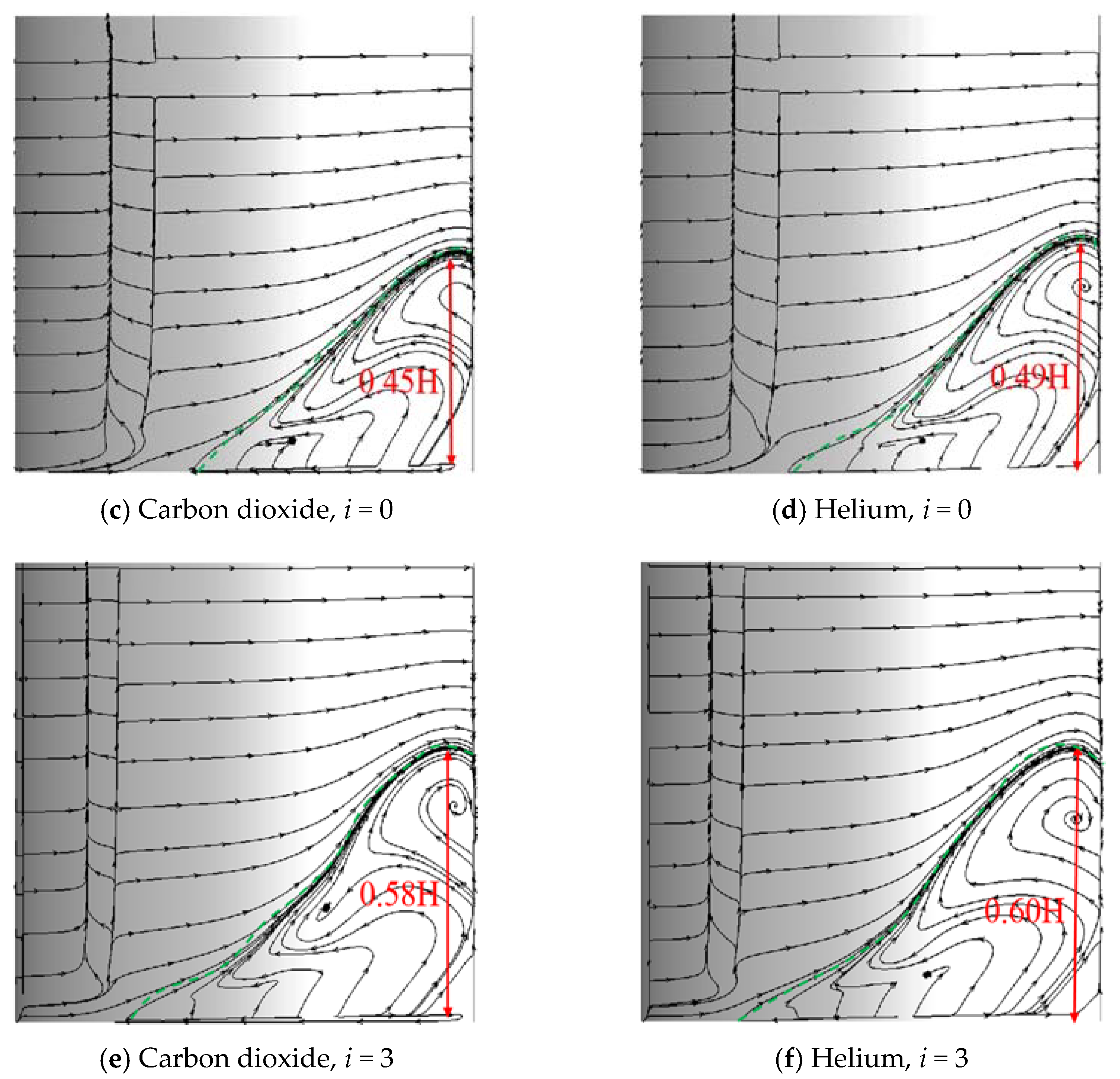
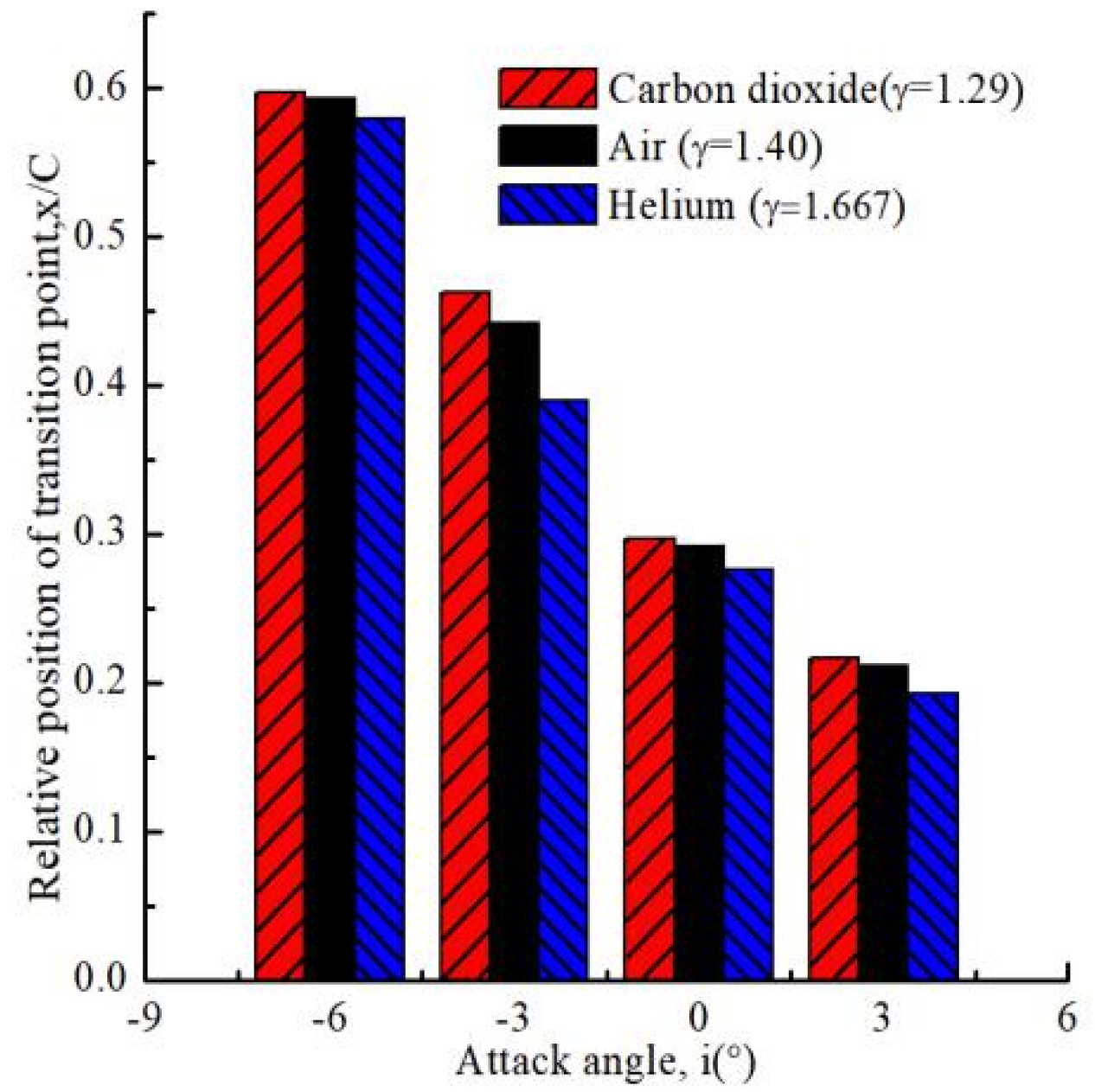
| Parameter | Value | Unit |
|---|---|---|
| Chord length (C) | 60 | [mm] |
| Inlet geometry angle (α1) | 48 | [°] |
| Aspect ratio | 1.67 | [/] |
| Axial chord length (Cx) | 55 | [mm] |
| Outlet geometry angle (α2) | 90 | [°] |
| Blade pitch (t) | 33 | [mm] |
| Grid Numbers (Million) | Mass Flow (kg/s) | Static Pressure Ratio |
|---|---|---|
| 0.75 | 0.2701 | 1.174 |
| 1.31 | 0.2698 | 1.176 |
| 1.78 | 0.2694 | 1.175 |
| 2.30 | 0.2699 | 1.176 |
Publisher’s Note: MDPI stays neutral with regard to jurisdictional claims in published maps and institutional affiliations. |
© 2021 by the authors. Licensee MDPI, Basel, Switzerland. This article is an open access article distributed under the terms and conditions of the Creative Commons Attribution (CC BY) license (http://creativecommons.org/licenses/by/4.0/).
Share and Cite
Tian, Z.; Wang, C.; Zheng, Q. Investigation of the Effects of Different Working Fluids on Compressor Cascade Performance. Appl. Sci. 2021, 11, 1989. https://doi.org/10.3390/app11051989
Tian Z, Wang C, Zheng Q. Investigation of the Effects of Different Working Fluids on Compressor Cascade Performance. Applied Sciences. 2021; 11(5):1989. https://doi.org/10.3390/app11051989
Chicago/Turabian StyleTian, Zhitao, Chengze Wang, and Qun Zheng. 2021. "Investigation of the Effects of Different Working Fluids on Compressor Cascade Performance" Applied Sciences 11, no. 5: 1989. https://doi.org/10.3390/app11051989
APA StyleTian, Z., Wang, C., & Zheng, Q. (2021). Investigation of the Effects of Different Working Fluids on Compressor Cascade Performance. Applied Sciences, 11(5), 1989. https://doi.org/10.3390/app11051989





